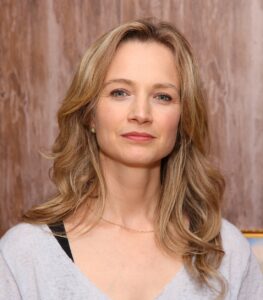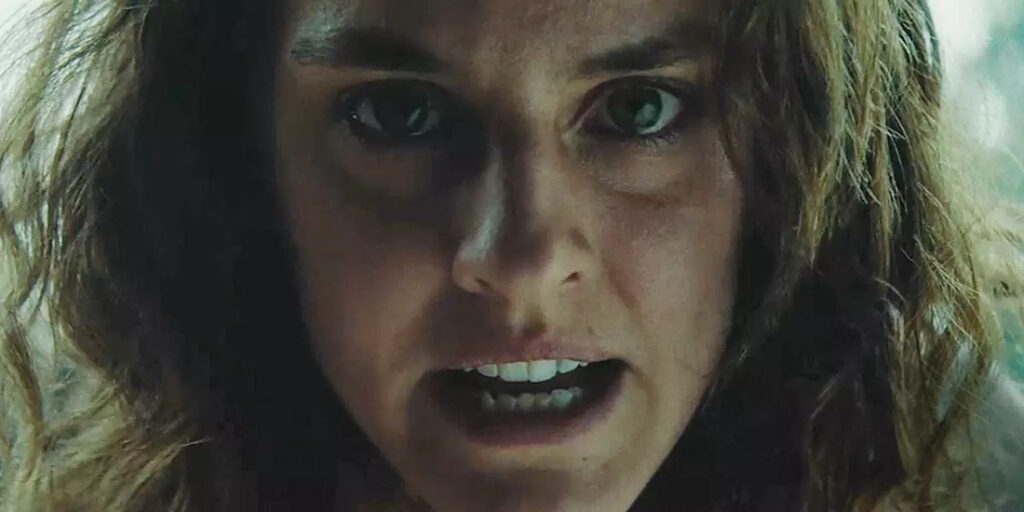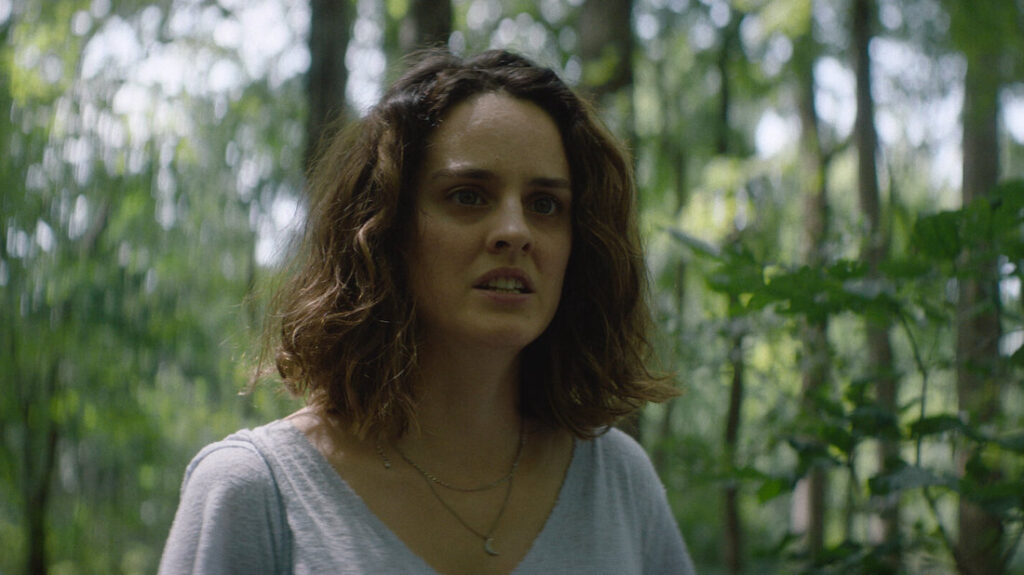Baby Ruby is written and directed by award-winning playwright, Bess Wohl, who offers a deeply personal look into her own challenging journey into motherhood. Nominated for a Tony award for her play Grand Horizons, Wohl is also a busy mother of three and adores her motherhood. “My kids are the best thing in my life!” says Wohl. But as much as she loves her family, she admits there are mysteries about motherhood that are difficult to speak about.
Wohl began writing the screenplay for Baby Ruby as an attempt to dig into some of these mysteries when she was pregnant with her third child. “I think I felt like this was the last time I was going to do this and I really wanted to somehow capture some of these feelings,” she says.
In the film, we meet Jo (Noémie Merlant), a social media influencer, who’s expecting her first child with her husband Spencer (Kit Harington). Though she’s excited to become a mother, it soon becomes clear she has no idea what she’s in for.

Bess Wohl (Photo Credit Walter McBride)
Jo struggles to care for her newborn and soon begins to question the motives of everyone around her – her husband, her mother-in-law (Jayne Atkinson), and the local moms in the neighborhood.
Could they all be conspiring behind Jo’s back? Worst of all, it seems that baby Ruby (played by twins, Gabriella and Lucas Thompson) is angry at her mother and is trying to undermine her in all sorts of malicious ways. Could Jo be losing her mind? Or is all this perfectly normal? Baby Ruby is about one woman’s psychological descent into the madness of motherhood where she can only rely on one person to get her out: herself.
Managing Tone Through Emotional Connection
The film stretches across several genres, at times delving into body horror and toying with supernatural tropes; other times it dips its toe into comedy and fantasy. Even though it contains all these different elements, the film keeps one foot firmly rooted in reality – something incredibly difficult to do. I asked her how she managed to keep the tone so grounded.
“It was a very tricky balancing act tonally throughout the script, throughout the shooting, and through the edit. It’s true the tone was very hard to nail because the movie doesn’t live in one particular tone. It’s flirting with different tones all the time – which to me, reflected the experience of motherhood – am I in a horror movie, or a drama, or a comedy? Am I in the deepest love story of my life? I felt like the movie had to have a tone that was complicated and nuanced as the experience itself,” she says.
To make the story believable, Wohl says the movie had to maintain a strong emotional connection to the main character, Jo. “I think that connection grounded everything in a psychological reality – even though some incredibly crazy things happen in the film.”
Play vs. Movie
When I asked Wohl why she chose to make this story a movie, not a play as she’s used to writing, she had two answers. The first is the challenge of a baby being a main character.
Wohl says the sheer logistical needs of working with a real-live baby made doing a stage play impossible. “You can’t have a baby in a play – well, The Ferryman [written by Jez Butterworth] did have a baby on stage for about 15 seconds and then it goes away. It can only be a tiny little stunt in the middle of a play,” she says.
Because Ruby is the antagonist in the story, we need to see her quite a bit. In the film, Ruby is played by twins due to the limited amount of hours a baby can work. And then there’s the question of cooperation.
“[A baby] is completely unpredictable on set. One thing I learned quickly is that if you plan to have the baby happy, it comes in crying that day. Or if there’s a scene where the baby is crying, it’s happy as a clam. You have to really adjust on the fly.” After all, the baby doesn’t know it’s acting!
The second reason Wohl knew Baby Ruby had to be a film and not a play was she wanted to create, “An internal, psychological space and film captures that really beautifully. Theatre to me feels more communal and social in some way. I felt the camera could really do things I didn’t know how to do on stage in terms of putting us in [Jo’s] world and allowing us to see her world through her eyes.”

‘Baby Ruby’
The Transition From Playwriting to Screenwriting
It’s no secret there are many differences between writing plays and screenplays. When I asked Wohl if it was difficult for her to go from one medium to the other, she said that writing a movie is always hard but her plays often deal with the unreliability of words making the transition a bit easier.
“Plays and screenplays are so deeply different,” says Wohl, “One, you’re telling a story with language vs. telling a story with images. In both mediums, I’m very interested in what the limitations of language are. One of my early plays is called Small Mouth Sounds and it happens mostly in silence, so I was already experimenting with peeling away dialogue and what you can do with images, discovering how economical I can be with what’s said. For me, that provided a really seamless transition to screenwriting because screenwriting is about what you can do with images. Figuring out what you need words for and balancing that. That’s why I was also so excited to have the opportunity to direct because I could be making these decisions in three dimensions with the actors.”
The Difficulty of Dialogue in Plays and Screenplays
For being such a successful playwright, it may seem surprising that Wohl is so suspicious of words. But it’s her dubious relationship with words that makes her work so relatable.
“So much of life happens without words. Many of the most important parts of life we don’t have words for. My plays are always in conflict with language in some way – characters barely say what they mean, often language is a smokescreen in my plays, so I’m always interested in how words fail us. That interrogation [of words] really fueled my interest in working more with images in film,” she says.

‘Baby Ruby’
Clearly, Wohl has thought deeply about both the power and failings of language. “We all have these feelings inside of us and often, language feels so insufficient. When you start playing with words you know you’re playing with a broken set of tools that will fail you. Because the feelings we have as people are just too complicated to fit into language a lot of the time. Words are these beautiful but flawed instruments that try to convey what’s inside of us. When people put up a smokescreen, sometimes it’s intentional but sometimes, and I often say this to actors when I’m working in theatre, ‘Your whole process of talking right now is it try to figure out what you’re trying to say.” It’s not like you know what you need to say and you say it like a chatbot would. You are searching for the thing as the words are coming out of your mouth in real-time.”
But Don’t Pare Down the Words Too Much in a Screenplay
Wohl also learned through the filmmaking process there are times when very little needs to be said and, how sometimes, saying something out loud is essential. “You can also overdo the paring down of words when transitioning from playwriting to screenwriting, so it was really about learning what the camera can do or what a close-up can do that makes language unnecessary. Also, learning where the words can explode off the screen and make a huge, huge difference,” she says.
Wohl’s Advice for Playwrights Transitioning to Screenwriting
Wohl says it’s very important to understand how screenplay structure works. “My experience has been that even the most seemingly avant-garde films adhere to a three-act structure which is really just a beginning, middle, and end. There are people who’ve expressed it in much more fancy ways, but it feels to me like screenplays have certain structural expectations – not really expectations of people in the industry but of people who go to the movies and want to be fulfilled. In plays, there’s much more structural freedom in terms of how you can arc your story. It’s a little bit less rigorous in that particular way. So, I would learn screenplay structure even if you decide to veer away from it or make your first act only three pages long – you can do anything once you know it.”
Read More: What Pro Script Readers Consider When Reading Cinematic Stage Plays
Her second piece of advice comes from personal experience. “I always thought that doing something for TV or film, I had to take out that messy, idiosyncratic thing that only belonged in my plays. That I had to do something more commercial. What I keep learning, time and time again, is that messy, idiosyncratic thing can live in the screenplay, in an episode of television – it’s not a thing you can abandon because you’re writing a movie now. The thing people want is that vulnerable, scary part of yourself.”
Baby Ruby is now playing in theaters and available on VOD.
The post Playwright Bess Wohl Explores Postpartum Psycho Horror in Film Debut ‘Baby Ruby’ appeared first on ScreenCraft.
Go to Source
Author: Shanee Edwards
